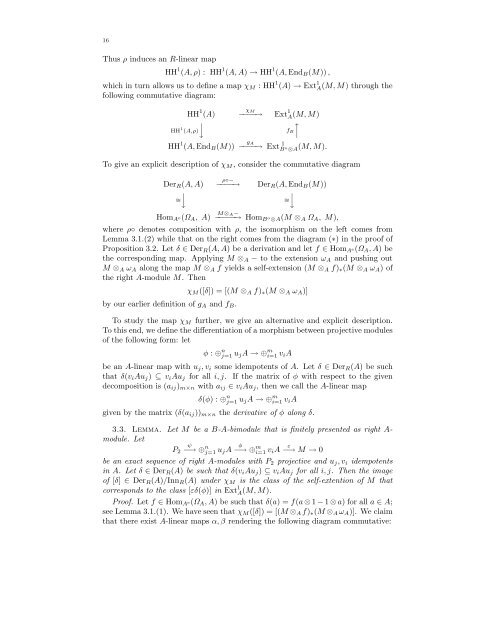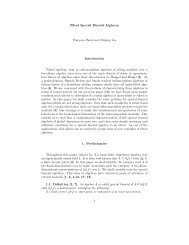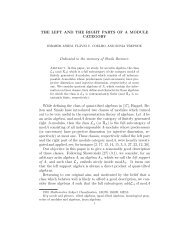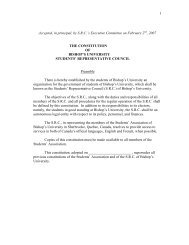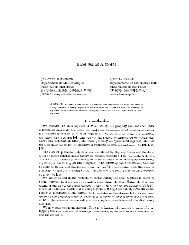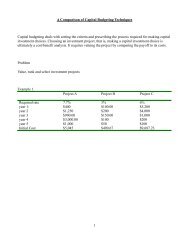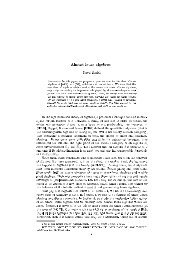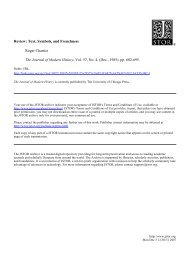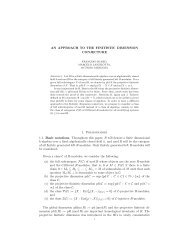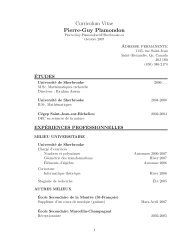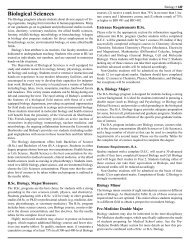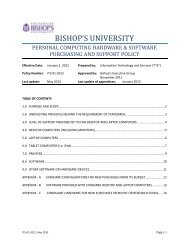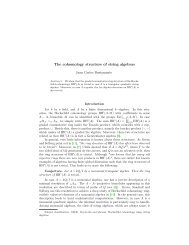Hochschild Cohomology and Representation-finite Algebras Ragnar ...
Hochschild Cohomology and Representation-finite Algebras Ragnar ...
Hochschild Cohomology and Representation-finite Algebras Ragnar ...
You also want an ePaper? Increase the reach of your titles
YUMPU automatically turns print PDFs into web optimized ePapers that Google loves.
16<br />
Thus ρ induces an R-linear map<br />
HH 1 (A, ρ) : HH 1 (A, A) → HH 1 (A, End B (M)) ,<br />
which in turn allows us to define a map χ M :HH 1 (A) → Ext 1 A (M,M) through the<br />
following commutative diagram:<br />
HH 1 (A,ρ)<br />
HH 1 (A)<br />
⏐<br />
↓<br />
χ M<br />
−−−−→<br />
Ext<br />
1<br />
A (M,M)<br />
↑<br />
f ⏐⏐<br />
B<br />
HH 1 (A, End B (M))<br />
g A<br />
−−−−→ Ext<br />
1<br />
Bo ⊗A(M,M).<br />
To give an explicit description of χ M , consider the commutative diagram<br />
Der R (A, A)<br />
⏐<br />
∼ ⏐↓ =<br />
ρ◦−<br />
−−−−→<br />
Der R (A, End B (M))<br />
⏐<br />
∼ ⏐↓ =<br />
M⊗<br />
Hom A e(Ω A ,A) −−−−−→ A−<br />
Hom B o ⊗A(M ⊗ A Ω A ,M),<br />
where ρ◦ denotes composition with ρ, the isomorphism on the left comes from<br />
Lemma 3.1.(2) while that on the right comes from the diagram (∗) in the proof of<br />
Proposition 3.2. Let δ ∈ Der R (A, A) be a derivation <strong>and</strong> let f ∈ Hom A e(Ω A ,A)be<br />
the corresponding map. Applying M ⊗ A − to the extension ω A <strong>and</strong> pushing out<br />
M ⊗ A ω A along the map M ⊗ A f yields a self-extension (M ⊗ A f) ∗ (M ⊗ A ω A )of<br />
the right A-module M. Then<br />
χ M ([δ]) = [(M ⊗ A f) ∗ (M ⊗ A ω A )]<br />
by our earlier definition of g A <strong>and</strong> f B .<br />
To study the map χ M further, we give an alternative <strong>and</strong> explicit description.<br />
To this end, we define the differentiation of a morphism between projective modules<br />
of the following form: let<br />
φ : ⊕ n j=1 u jA →⊕ m i=1 v iA<br />
be an A-linear map with u j ,v i some idempotents of A. Let δ ∈ Der R (A) besuch<br />
that δ(v i Au j ) ⊆ v i Au j for all i, j. If the matrix of φ with respect to the given<br />
decomposition is (a ij ) m×n with a ij ∈ v i Au j ,thenwecalltheA-linear map<br />
δ(φ) :⊕ n j=1 u j A →⊕ m i=1 v i A<br />
given by the matrix (δ(a ij )) m×n the derivative of φ along δ.<br />
3.3. Lemma. Let M be a B-A-bimodule that is <strong>finite</strong>ly presented as right A-<br />
module. Let<br />
ψ<br />
P 2 −→ ⊕ n j=1 u j A −→ φ<br />
⊕ m i=1 v i A −→ ε<br />
M → 0<br />
be an exact sequence of right A-modules with P 2 projective <strong>and</strong> u j ,v i idempotents<br />
in A. Letδ ∈ Der R (A) be such that δ(v i Au j ) ⊆ v i Au j for all i, j. Then the image<br />
of [δ] ∈ Der R (A)/Inn R (A) under χ M is the class of the self-extention of M that<br />
corresponds to the class [εδ(φ)] in Ext 1 A (M,M).<br />
Proof. Let f ∈ Hom A e(Ω A ,A) be such that δ(a) =f(a ⊗ 1 − 1 ⊗ a) for all a ∈ A;<br />
see Lemma 3.1.(1). We have seen that χ M ([δ]) = [(M ⊗ A f) ∗ (M ⊗ A ω A )]. We claim<br />
that there exist A-linear maps α, β rendering the following diagram commutative:


